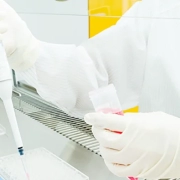Questions to Ask When Choosing a Multiplex Assay Kit
With the COVID‑19 pandemic in full swing, many researchers are looking to multiplex assays to evaluate what they call the “cytokine storm.”
The “cytokine storm” refers to the increase in pro-inflammatory cytokines like IL-6 in patients with COVID‑19, which is believed to predict disease severity.1 Many of Luminex’s Partners already have multiplex assays available for research use. But because there are many kits available for all types of research, we put together a list of questions to consider when determining which assay would work best for you.
Q: Will my samples fall within the dynamic range of the assay?
A: The dynamic range of the assay should include values that you expect your samples to fall in. If you are analyzing endogenous samples, you may need a range that covers lower concentrations. When looking at induced or disease state models, a range that includes higher concentrations would be more suitable. When evaluating both, an assay with a large dynamic range is best.
Q: What is the sensitivity of the assay?
A: Because endogenous levels of analytes can be very low, it is important that the sensitivity of the assay is high enough that it can detect low levels of analytes in your samples if needed.
Q: What is the accuracy of the kit?
A: When researching kits, evaluate the vendor-provided accuracy data. This should be provided with all kits. A range of 80–120% when performing a spike-and-recovery experiment is the industry standard.
Q: What is the intra- and inter-assay precision?
A: It is important that your results are precise and accurate, whether all samples are contained on one plate or are on multiple plates—this is vital when evaluating different treatment groups. You want any differences seen between groups to be solely due to treatment effects, not a variation in your assay.
Q: What is the lot-to-lot variability of the kit and how is it evaluated?
A: When you are expecting to evaluate samples over a long period of time, it is important to determine the lot-to-lot variability of the assay to ensure reliable, accurate, and consistent results. This is especially important in pre-clinical work, when evaluating several compounds in an animal model over months or years, or when processing a large number of samples whose evaluation will exceed a single lot of kits.
Q: What is the percent of cross-reactivity between analytes?
A: When multiple analytes are present in one assay, cross-reactivity between the capture or detection reagents can occur, leading to inaccurate results. This information should be provided by the vendor, and any kits with high cross-reactivity should be avoided.
Q: How does the kit account for matrix effects?
A: All matrices—including plasma, serum, cell culture media, and tissue homogenates—can affect the performance of the assay. Ensure that the kit either provides a buffer to prevent these effects or provides instruction on how they can be mitigated.
References:
- Puja M, et al. COVID-19: consider cytokine storm syndromes and immunosuppression. The Lancet, 2020 Mar 13. 395, 10229; 1033-1034. Available from: https://doi.org/10.1016/S0140-6736(20)30628-0.
Related Resources:
- Find Custom Assay Development Assistance [Resource]
- xMAP® Technology for Multiplex COVID-19 Serology Assays [Webpage]
- How Luminex is Supporting Research Partners’ Pandemic Response [Blog]
- Considerations Regarding RNA Extraction Kits for SARS-CoV-2 Detection [Blog]
- xMAP® Cookbook to Design Your Own Assays [Download]
- Getting Started with xMAP® Technology [Video]

















![Development of A Multiplex Serological Assay for Avian Influenza [VIEW NOW]](https://no-cache.hubspot.com/cta/default/128032/f482a58d-9b8b-416f-861d-8d9622f9cf9b.png)
